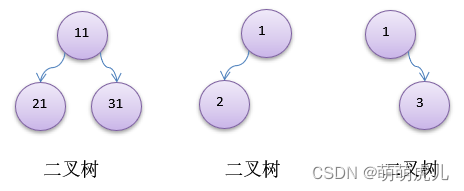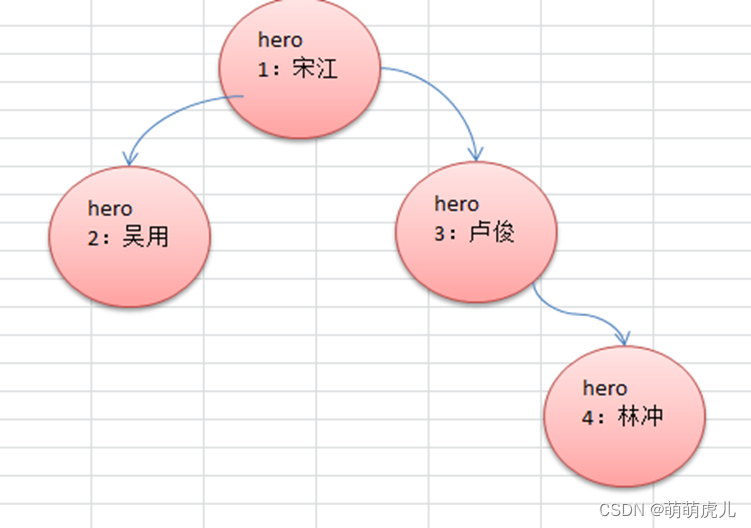一、为什么需要树这种数据结构
1)
数组存储方式的分析
优点:通过下标方式访问元素,速度快。 对于有序数组 ,还可使用二分查找提高检索速度。
缺点:如果要检索具体某个值,或者插入值( 按一定顺序 ) 会整体移动 ,效率较低
优点:通过下标方式访问元素,速度快。 对于有序数组 ,还可使用二分查找提高检索速度。
缺点:如果要检索具体某个值,或者插入值( 按一定顺序 ) 会整体移动 ,效率较低
2
)
链式存储方式的分析
优点:在一定程度上对数组存储方式有优化( 比如:插入一个数值节点,只需要将插入节点,链接到链表中即可, 删除效率也很好 ) 。
缺点:在进行检索时,效率仍然较低,比如( 检索某个值,需要从头节点开始遍历)
优点:在一定程度上对数组存储方式有优化( 比如:插入一个数值节点,只需要将插入节点,链接到链表中即可, 删除效率也很好 ) 。
缺点:在进行检索时,效率仍然较低,比如( 检索某个值,需要从头节点开始遍历)
树存储方式的分析
能提高数据存储,读取的效率, 比如利用 二叉排序树(Binary Sort Tree),既可以保证数据的检索速度,同时也可以保证数据的插入,删除,修改的速度。

二、二叉树的概念
1)
树有很多种,每个节点
最多只能有两个子节点
的一种形式称为二叉树。
2)
二叉树的子节点分为左节点和右节点。
3)如果该二叉树的
所有叶子节点都在最后一层,并且结点总数= 2^n -1 , n 为层数,则我们称为
满二叉树。
4)
如果该二叉树的所有叶子节点都在最后一层或者倒数第二层,而且最后一层的叶子节点在左边连续,倒数第二层的叶子节点在右边连续,我们称为完全二叉树。


三、二叉树的定义
1.先定义节点:
class Node{
private int no;
private String name;
private Node left;
private Node right;
public Node(int no, String name) {
this.no = no;
this.name = name;
}
public int getNo() {
return no;
}
public void setNo(int no) {
this.no = no;
}
public String getName() {
return name;
}
public void setName(String name) {
this.name = name;
}
public Node getLeft() {
return left;
}
public void setLeft(Node left) {
this.left = left;
}
public Node getRight() {
return right;
}
public void setRight(Node right) {
this.right = right;
}
2.再定义二叉树
lass BinaryTree{
private Node root;
public Node getRoot() {
return root;
}
public void setRoot(Node root) {
this.root = root;
}
public BinaryTree(Node root) {
this.root = root;
}四、二叉树的遍历
前序遍历: 先输出父节点,再遍历左子树和右子树
中序遍历: 先遍历左子树,再输出父节点,再遍历右子树
后序遍历: 先遍历左子树,再遍历右子树,最后输出父节点
小结: 看输出父节点的顺序,就确定是前序,中序还是后序:

1.Node类中
//前序遍历
public void preOrder(){
System.out.println(this);//根
if(this.left!=null){//左
this.left.preOrder();
}
if(this.right!=null){//右
this.right.preOrder();
}
}
//中序遍历
public void infixOrder(){
if(this.left!=null){//左
this.left.infixOrder();
}
System.out.println(this);//根
if(this.right!=null){//右
this.right.infixOrder();
}
}
//后序遍历
public void afterOrder(){
if(this.left!=null){//左
this.left.afterOrder();
}
if(this.right!=null){//右
this.right.afterOrder();
}
System.out.println(this);//根
}2.BinaryTree类中
//前序遍历
public void preOrder(){
if(this.root!=null){
this.root.preOrder();
}else System.out.println("二叉树为空!");
}
//中序遍历
public void infixOrder(){
if(this.root!=null){
this.root.infixOrder();
}else System.out.println("二叉树为空!");
}
//后序遍历
public void afterOrder(){
if(this.root!=null){
this.root.afterOrder();
}else System.out.println("二叉树为空!");
}3.测试
@Test
public void testOrder(){
Node root=new Node(1,"a");
Node node1=new Node(2,"b");
Node node2=new Node(3,"c");
Node node3=new Node(4,"d");
BinaryTree tree=new BinaryTree(root);
root.setLeft(node1);
root.setRight(node2);
node2.setRight(node3);
tree.preOrder();//1,2,3,4
tree.infixOrder();//2,1,3,4
tree.afterOrder();//2,4,3,1
Node{no=1, name='a'}
Node{no=2, name='b'}
Node{no=3, name='c'}
Node{no=4, name='d'}
Node{no=2, name='b'}
Node{no=1, name='a'}
Node{no=3, name='c'}
Node{no=4, name='d'}
Node{no=2, name='b'}
Node{no=4, name='d'}
Node{no=3, name='c'}
Node{no=1, name='a'}
五、二叉树查找节点
类似于遍历
1.Node类中
//前序查找
public Node preOrderSearch(int no){
//先遍历根节点,如果找到就返回
if(this.no==no) return this;
Node temp=null;
//没找到就看是否有左节点,有的话就对左子节点做前序遍历
if(this.left!=null){
temp=this.left.preOrderSearch(no);
}
//在左子节点找到了目标,则返回
if(temp!=null) return temp;
//没找到就看是否有右节点,有的话就对右子节点做前序遍历
if(this.right!=null){
temp=this.right.preOrderSearch(no);
}
//遍历完右子节点,不管是否为空都返回
return temp;
}
//中序查找
public Node infixOrderSearch(int no){
Node temp=null;
//先遍历左节点
if(this.left!=null){
temp=this.left.infixOrderSearch(no);
}
if(temp!=null) return temp;
//再遍历根节点
if(this.no==no) return this;
//最后遍历右节点
if(this.right!=null){
temp=this.right.infixOrderSearch(no);
}
return temp;
}
//后序查找
public Node afterOrderSearch(int no){
Node temp=null;
//先遍历左节点
if(this.left!=null){
temp=this.left.afterOrderSearch(no);
}
if(temp!=null) return temp;
//再遍历右节点
if(this.right!=null){
temp=this.right.afterOrderSearch(no);
}
if(temp!=null) return temp;
//最后遍历根节点
if(this.no==no) return this;
return temp;
}2.BinaryTree类中
//前序遍历查找
public Node preOrderSearch(int no){
if(this.root!=null){
return this.root.preOrderSearch(no);
}else return null;
}
//中序遍历查找
public Node infixOrderSearch(int no){
if(this.root!=null){
return this.root.infixOrderSearch(no);
}else return null;
}
//后序遍历查找
public Node afterOrderSearch(int no){
if(this.root!=null){
return this.root.afterOrderSearch(no);
}else return null;
}3.测试
@Test
public void testSearch(){
Node root=new Node(1,"a");
Node node1=new Node(2,"b");
Node node2=new Node(3,"c");
Node node3=new Node(4,"d");
BinaryTree tree=new BinaryTree(root);
root.setLeft(node1);
root.setRight(node2);
node2.setRight(node3);
System.out.println("前序查找:"+tree.preOrderSearch(5));
System.out.println("中序查找:"+tree.preOrderSearch(4));
System.out.println("后序查找:"+tree.preOrderSearch(4));
}
前序查找:null
中序查找:Node{no=4, name='d'}
后序查找:Node{no=4, name='d'}六、二叉树删除节点
1).删除的是子节点,那么就直接删除
2).删除的是中间节点,那就连带它的子树全部删除
1.Node类
//删除节点(包括其子节点)
public Boolean delNode(int no){
//先看某节点的左节点是不是要删除的
if(this.left!=null && this.left.no==no){
this.left=null;
return true;
}
//再看某节点的右节点是不是要删除的
if(this.right!=null && this.right.no==no){
this.right=null;
return true;
}
//如果都不是,就遍历到该节点的左子节点继续判断
if(this.left!=null){
this.left.delNode(no);
}
//如果还是没找到,就再遍历到该节点的右子节点继续判断
if(this.right!=null){
this.right.delNode(no);
}
return false;
}2.BinaryTree类
//删除节点(包括其子节点)
public Boolean delNode(int no){
//根节点不为空
if(root!=null){
//要删除根节点
if(root.getNo()==no){
root=null;
return true;
//要删除的不是根节点
}else return root.delNode(no);
}else {
System.out.println("树为空,不能删除!");
return false;
}
}3.测试
@Test
public void testDel(){
Node root=new Node(1,"a");
Node node1=new Node(2,"b");
Node node2=new Node(3,"c");
Node node3=new Node(4,"d");
BinaryTree tree=new BinaryTree(root);
root.setLeft(node1);
root.setRight(node2);
node2.setRight(node3);
System.out.println("删除前:");
tree.preOrder();
tree.delNode(3);
System.out.println("删除后:");
tree.preOrder();
}
删除前:
Node{no=1, name='a'}
Node{no=2, name='b'}
Node{no=3, name='c'}
Node{no=4, name='d'}
删除后:
Node{no=1, name='a'}
Node{no=2, name='b'}
总结
二叉树的遍历、查找、初级删除操作都有清晰的步骤可循,都可以用递归以较少的代码量完成。但注意要判断节点是否为空,否则会有空指针异常的风险。






















 243
243











 被折叠的 条评论
为什么被折叠?
被折叠的 条评论
为什么被折叠?








